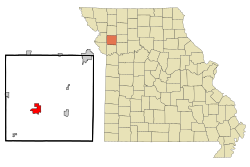Plattsburg, Missouri
| Plattsburg, Missouri | |
|---|---|
| City | |
 Location of Plattsburg, Missouri |
|
| Coordinates: 39°33′52″N 94°27′12″W / 39.56444°N 94.45333°WCoordinates: 39°33′52″N 94°27′12″W / 39.56444°N 94.45333°W | |
| Country | United States |
| State | Missouri |
| County | Clinton |
| Area | |
| • Total | 3.63 sq mi (9.40 km2) |
| • Land | 3.60 sq mi (9.32 km2) |
| • Water | 0.03 sq mi (0.08 km2) |
| Elevation | 948 ft (289 m) |
| Population (2010) | |
| • Total | 2,319 |
| • Estimate (2012) | 2,290 |
| • Density | 640/sq mi (250/km2) |
| Time zone | Central (CST) (UTC-6) |
| • Summer (DST) | CDT (UTC-5) |
| ZIP code | 64477 |
| Area code(s) | 816 |
| FIPS code | 29-58250 |
| GNIS feature ID | 0730179 |
| Website | plattsburgmo.com |
Plattsburg is a city and county seat of Clinton County, Missouri, United States, which is located along the Little Platte River. As of the 2010 census, the city population was 2,319.
The area along the rivers had been occupied for thousands of years by indigenous peoples. Historic American Indian tribes in the area included the Ioway, Fox and Sac tribes, who ceded land in what became northwest Missouri in the Platte Purchase.
The European-American settlers first called their settlement Concord. (This has been used for a contemporary man-made lake and surrounding housing development in the city.) Later the city was renamed Springfield. After the discovery of a preceding Springfield, Missouri, settlers named it "Plattsburg," after Plattsburgh, New York, which is the seat of Clinton County, New York. Both it and Clinton County, Missouri were named for George Clinton, one of the Founding Fathers, the first governor of New York, and vice president from 1805 to 1812.
The area was settled chiefly by migrants from the Upper South, especially Kentucky and western Virginia, and was near what was called "Little Dixie" in Missouri. They brought their slaves and culture with them. For a brief period of time during the 1830s, Plattsburg was home to a Federal land office for areas of northern Missouri that were newly opened to settlement by European Americans after the Platte Purchase in 1836. Until then, Plattsburg was one of the farthest western non-military settlements.
...
Wikipedia
